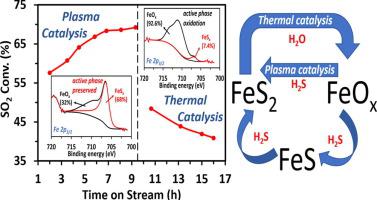Journal of Catalysis ( IF 6.5 ) Pub Date : 2020-08-21 , DOI: 10.1016/j.jcat.2020.08.013 Mohammad S. AlQahtani , Xiaoxing Wang , Jennifer L. Gray , Sean D. Knecht , Sven G. Bilén , Chunshan Song

|
Herein, we report on low-temperature sulfur dioxide (SO2) reduction to elemental sulfur via the coupling of nonthermal plasma (NTP) with supported transition metal sulfide catalysts in a dielectric barrier discharge (DBD) reactor. The transition metals include Mo, Fe, Co, Ni, Cu, and Zn. Combining NTP with supported metal sulfide catalysts significantly promotes low-temperature reduction of SO2 by 148–200%, with over 98% selectivity to elemental sulfur. Over FeS2/Al2O3 catalyst at low temperatures (<250 °C), temperature does not influence SO2 conversion in the plasma catalytic process, whereas at higher temperatures, the reaction follows a similar trend as thermal catalysis. Strong synergistic effects are attained, as the sulfur yield is about 47–82% higher than the sum of the yield when using DBD-plasma and thermal catalysis separately. The physico−chemical properties of fresh and spent FeS2/Al2O3 catalysts after thermal and plasma reactions are evaluated by N2 physisorption, FESEM, XPS, XRD, HRTEM, STEM/EDS, and EELS to understand plasma and thermal effects on the catalyst. Our investigations reveal that running the reaction under plasma preserves the surface FeS2 active phase, preventing its oxidation that otherwise occurs in the thermal catalysis process. Furthermore, plasma inhibits the thermal agglomeration of iron sulfide nanoparticles under reaction conditions.
中文翻译:

等离子体辅助SO 2催化还原为元素硫:非热等离子体和温度对硫化铁催化剂的影响
在这里,我们报道了在介质阻挡放电(DBD)反应器中,通过将非热等离子体(NTP)与负载型过渡金属硫化物催化剂偶联,将低温二氧化硫(SO 2)还原为元素硫。过渡金属包括Mo,Fe,Co,Ni,Cu和Zn。NTP与负载型金属硫化物催化剂的组合可显着促进SO 2的低温降低148-200%,对元素硫的选择性超过98%。在低温(<250°C)下使用FeS 2 / Al 2 O 3催化剂,温度不影响SO 2在等离子催化过程中发生转化,而在较高温度下,反应遵循与热催化相似的趋势。由于硫的收率比分别使用DBD等离子体和热催化法的收率总和高约47-82%,因此获得了强大的协同效应。通过N 2物理吸附,FESEM,XPS,XRD,HRTEM,STEM / EDS和EELS评估热和等离子体反应后新鲜的和用过的FeS 2 / Al 2 O 3催化剂的理化性质,以了解其对等离子体和热的影响。催化剂。我们的研究表明,在等离子体下进行反应可保留表面FeS 2活性相,防止其在热催化过程中发生氧化。此外,等离子体在反应条件下抑制了硫化铁纳米颗粒的热团聚。









































 京公网安备 11010802027423号
京公网安备 11010802027423号